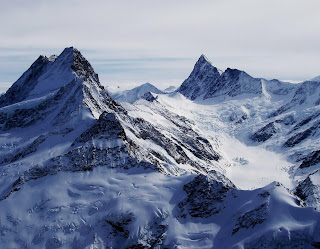The Alps contain some of Switzerland's most dramatic landscapes, in a country that is already blessed with spectacular scenery and striking alpine vistas. Situated at the heart of the Alps, Switzerland shares the mountain range with France, Italy and Austria and provides winter and summer-time enjoyment for skiers, snowboarders, hikers and climbers. The Jungfra (German for "maiden") is one of the main summits in the Alps. Together with Eiger and Monch, form a prodigious wall overlooking the Bernise Oberland and is considered on of the most emblematic sights of the Swiss Alps. The North Face (of Eiger) towers 1,800 (m) above the valley, since 1935, at least 64 climbers have died while attempting to scale the north face, earning it the ominous nickname Mordwand (Death Wall).
Finsteraarhorn (4,274m) is the highest mountain in the Bernese Alps, however, the summit of this peak is far less frequented than those of the nearby Jungfrau and Eiger. This is mainly due to it's location in one of the most remote areas in the Alps, completely surrounded by un-inhabited and inhospitable glacial valleys.
Lyskamm is a mountain in the Pennine Alps which has gained a nasty reputation leading to it's nickname Menschenfresser (man eater). The mountain has gained this reputation because of it's many cornices (overhanging edge of snow) lying on the ridge and ubiquitous avalanches. The traverse consists mostly of a narrow, snow-covered ridge, with some scrambling over rocks, in bad snow conditions (or visibility) the ridge can be extremely challenging worsened from the large (sometimes double) cornices.
Europe contains some of the world's largest vertical relief available to mountaineers, including lines that exceed the scale of Himalayan routes. Tödie in particular, can be generally consisdered one of the most difficult lines in the Alps, including an almost 10,000-foot descent.






















